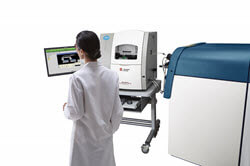
SWATH® Acquisition: On the Forefront of HIV-1 Research
World AIDS Day is held on the 1st December each year and is an opportunity for people worldwide to unite in the fight against HIV, show their support for people living with HIV, and to commemorate people who have died. World AIDS Day was the first ever global health day, held for the first time in 1988.
A research team at the University of Nebraska Medical Center (UNMC) is using SWATH Acquisition to advance a host-oriented antiviral strategy that targets the biomolecules required for viral replication.
Using SWATH for quantitative proteomics together with bioinformatic analyses to identify host proteins, the team quantified the expression of 3,608 proteins in uninfected and HIV-1-infected monocyte-derived microphages.
Of these, they found that 420 were significantly altered upon HIV-1 infection, and the findings highlighted a novel set of proteins and processes that are involved in the host response to HIV-1 infection.
Journal of Proteomics Research, 2014, April 4; Drs. P. Ciborowski, N. Haverland, H. Fox, University of Nebraska Medical Center or VIEW the webinar (May 2014) by Drs. Pawel Ciborowski and Nicole Haverland
In this informative presentation, you’ll learn:
- How to design a SWATH spectral library for a nucleic acid binding protein interactome using whole cell lysates
- A unique informatics strategy that takes advantage of SWATH measurement reproducibility to overcome biological variations in compared samples






 Contact Support
Contact Support
0 Comments